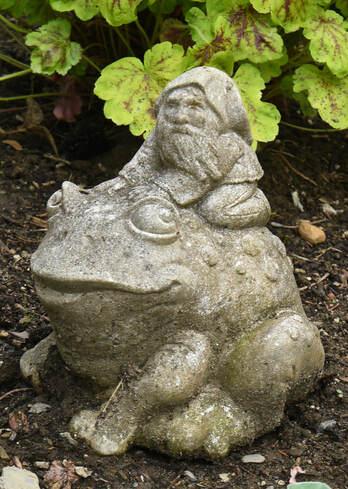This blog is a little unusual so let me tell you of its evolution. While waiting for 'Meet the Member' stories from the GGC crowd, I went through my garden photos looking for inspiration and was thrilled with where it led me. I had taken lot of pictures of whimsical garden statues including this jolly guy who guards Janie Clark's garden 24/7. I started to do a little research about garden gnomes and dwarfs which resulted in so much strange and interesting information that I have written my first two-part blog.
The allure of having quiet helpers in the garden dates back to the second century AD when the Roman emperor Hadrian had hermits living throughout his villa’s garden. This idea caught on again in 18th-century England when wealthy landowners would hire a person to be an “ornamental hermit” in their garden. They were required to live in rustic outbuildings (or hermitages), wear disheveled clothes and grow beards. Having a hermit living in your garden became fashionable in Georgian England. Some historians believe that this garden hermit fad paved the road for garden gnome popularity in Britain.
Once the hermitages and their hermits fell out of favor, ceramic garden gnomes were offered as a less expensive and more humane garden décor. As early as the 1600s, garden statuary in Europe had evolved to include a key figure known as gobbi which isItalian for “dwarf.” In 19th-century Germany, these diminutive men with pointed hats, round bellies, and white beards became known as Gartenzwerge (garden gnomes).
In 1847 English baronet Sir Charles Edmund Isham bought twenty-one terra cotta garden gnomes from a German manufacturer to decorate his rockery. After Sir Charles passed away, his ungrateful daughters had all of them removed. One gnome was in a secluded spot and managed to elude his captors. He wasn’t found until 1940 when he became famous as the oldest garden gnome in the world. He was nicknamed Lampy after the luxurious Lamport Hall where he now lives indoors given his age and value. He is insured for £1 million.
Next Friday's blog also includes a story about living dwarfs--stay tuned....
The allure of having quiet helpers in the garden dates back to the second century AD when the Roman emperor Hadrian had hermits living throughout his villa’s garden. This idea caught on again in 18th-century England when wealthy landowners would hire a person to be an “ornamental hermit” in their garden. They were required to live in rustic outbuildings (or hermitages), wear disheveled clothes and grow beards. Having a hermit living in your garden became fashionable in Georgian England. Some historians believe that this garden hermit fad paved the road for garden gnome popularity in Britain.
Once the hermitages and their hermits fell out of favor, ceramic garden gnomes were offered as a less expensive and more humane garden décor. As early as the 1600s, garden statuary in Europe had evolved to include a key figure known as gobbi which isItalian for “dwarf.” In 19th-century Germany, these diminutive men with pointed hats, round bellies, and white beards became known as Gartenzwerge (garden gnomes).
In 1847 English baronet Sir Charles Edmund Isham bought twenty-one terra cotta garden gnomes from a German manufacturer to decorate his rockery. After Sir Charles passed away, his ungrateful daughters had all of them removed. One gnome was in a secluded spot and managed to elude his captors. He wasn’t found until 1940 when he became famous as the oldest garden gnome in the world. He was nicknamed Lampy after the luxurious Lamport Hall where he now lives indoors given his age and value. He is insured for £1 million.
Next Friday's blog also includes a story about living dwarfs--stay tuned....







 RSS Feed
RSS Feed